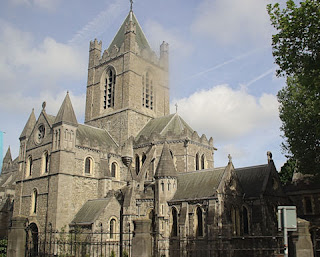From the Republic of Ireland we crossed the invisible border to Northern Ireland, which is part of the United Kingdom. We wouldn’t have known we were crossing the border if our tour director hadn’t told us. We didn’t even need our passports, although the currency changed from the Euro to the British pound.
Northern Ireland may have been
slightly greener, but the main differences weren’t in the scenery. For most of Ireland’s
existence, there wasn’t much difference in the history, either.
And then there was.
England conquered Ireland over a
century ago and has had an uneasy relationship with it ever since. In 1920,
Great Britain partitioned Ireland into two separate jurisdictions, although
both were still part of the United Kingdom. Then in 1948 most of Ireland gained
its complete independence, while the six northernmost counties continued to be
part of the UK. That’s still the situation today.
Many people have heard of the violence
in Northern Ireland (referred to as “the Troubles) from the late 1960s until 1998.
Although on the surface it appeared to be a religious struggle between the
Roman Catholics and the Protestants, it was really a political struggle between
those who wanted independence (who happened to be primarily Roman Catholics)
and those who wanted to remain part of the United Kingdom (who were mostly
Protestants). As the violence escalated, most people stayed in their own,
segregated neighborhoods because they were safer there, although those
boundaries weren’t always respected. Finally, a political peace was brokered in
1998 by a group headed by John Hume, who received the Nobel Peace Prize and two
other peace prizes for his work. The second photo is one of many murals in
Derry and, according to our tour director, it shows one of the first innocent
child victims, a schoolgirl who was leaving a store at the time. The third shows
the peace prizes awarded to John Hume, which are displayed in the Guild Hall in
Derry.
Also while in Derry, we walked partway across the Peace Bridge, which winds back and forth to show that the road to peace is never straight.
In Belfast, we saw and signed a “peace
wall.” These walls were built to separate the neighborhoods during the Troubles.
Most have since been torn down, but this one remains. Although it does separate
the still segregated neighborhoods, it appears to be mostly a tourist
attraction now. Tour buses stop there, as ours did, so that anyone who wants to
can sign their name on the wall, presumably in support of peace. The photo at
the head of this post shows me signing the peace wall at one of the few
available spots I could reach, although Roland had to help me up afterwards.
Because of his height, he had an easier time finding a space. The next two
photos show the Peace Bridge in Derry and Roland signing the peace wall in
Belfast.
The other “war and peace” story we heard was just that—a legend that obviously has no truth to it but is a fun tale. While staying in Belfast, we took a day trip to the Giant’s Causeway, which is a natural formation created by volcanic activity. It resembles the foundations for a causeway, and there is apparently a similar formation thirteen miles away in Scotland. So the story goes like this.
An Irish giant and a Scottish giant heard
about each other and wanted to have a fight, so the Irish giant built a a
causeway between Ireland and Scotland. When the Irish giant saw the Scottish
giant, however, he realized that he was a dwarf in comparison. He hurried back
home and his wife dressed him up like a baby. When the Scottish giant came
looking for the Irish giant, he saw the “baby.” The Scottish giant thought, “if
the baby is that big, the father must be huge,” so he fled back to Scotland destroying
the causeway on his way.
The next three photos are various
views of the Giant’s Causeway.
Two other stops in Northern Ireland are worth noting. The Titanic was built in Belfast, and we visited a museum at the shipyards. there. The museum is built to look like a ship’s hull if you look at it from the right direction. We also saw two waterfalls on our trip. Neither was very impressive, but since I love waterfalls I will include the one we saw on our way to Derry. The final two photos show the Titanic Museum and Glencar Waterfall.
That’s it from Ireland.










































